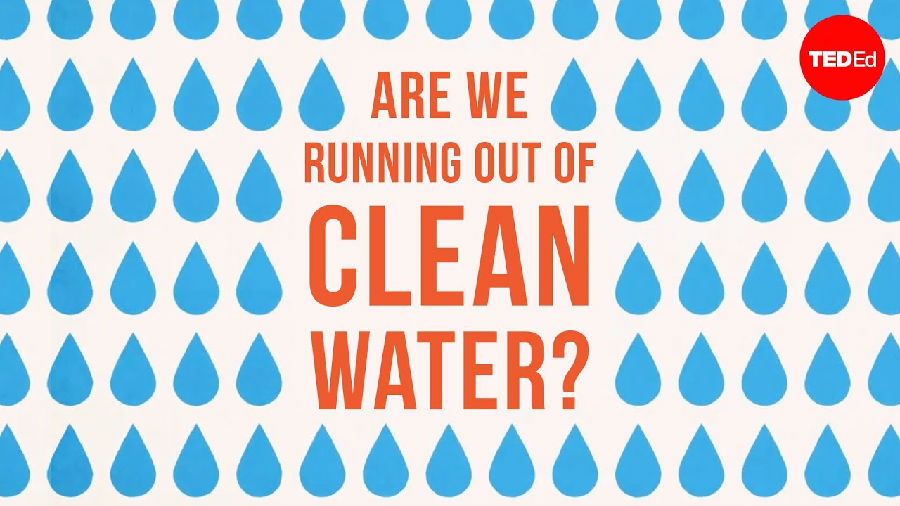From space, our planet appears to be more ocean than Earth.
从外太空看,我们的星球上海洋比土地更多。
But despite the water covering 71% of the planet's surface,
尽管地球表面的71%覆盖着水,
more than half the world's population endures extreme water scarcity for at least one month a year.
世界上超过一半人口每年至少有一个月要经受严重缺水。
And current estimates predict that by 2040, up to 20 more countries could be experiencing water shortages.
以目前预计,到了2040年会新增20个国家陷入用水短缺。
Taken together, these bleak statistics raise a startling question: are we running out of clean water?
总的说来,这些冰冷的统计数据带来了一个骇人的问题:我们将会用尽仅有的净水吗?
Well yes, and no. At a planetary scale, Earth can't run out of freshwater thanks to the water cycle,
嗯,也是,也不是。就行星而言,地球不会用完淡水得益于水循环系统,
a system that continuously produces and recycles water, morphing it from vapour, to liquid, to ice as it circulates around the globe.
该系统不断地产生和回收水,将其形态不断汽化、液化、固化,并在全球循环往复。
So this isn't really a question of how much water there is, but of how much of it is accessible to us.
所以问题并不在于水有多少,而是我们能得到多少水。
97% of earth's liquid is saltwater, too loaded with minerals for humans to drink or use in agriculture.
地球上97%的水是海水,对人类来说矿物质太多了,不合适饮用或灌溉。
Of the remaining 3% of potentially usable freshwater, more than two-thirds is frozen in ice caps and glaciers.
在剩下3%的淡水中,三分之二以上都封存于冰盖和冰川之中。
That leaves less than 1% available for sustaining all life on Earth,
只有不到1%的水可以维持地球上所有生命,
spread across our planet in rivers, lakes, underground aquifers, ground ice and permafrost.
而这些净水遍布于江河、湖泊、地下蓄水层、地下冰和永冻层。
It's these sources of water that are being rapidly depleted by humans, but slowly replenished by rain and snowfall.
人类正在快速地消耗着这些水源,而雨雪的补充却很慢。
And this limited supply isn't distributed evenly around the globe.
这些有限的水源在全球的分布不是平均的。
Diverse climates and geography provide some regions with more rainfall and natural water sources,
不同的气候和地理为某些地区带来不绝的雨水和自然水资源,
while other areas have geographic features that make transporting water much more difficult.
其他地区的地理因素令引水艰难。
And supplying the infrastructure and energy it would take to move water across these regions is extremely expensive.
这些地区的引水工程和能源消耗费用极为昂贵。
In many of these water-poor areas, as well as some with greater access to water,
在很多缺水的地方和水资源充裕的地方,
humanity is guzzling up the local water supply faster than it can be replenished.
人类的用水量都超越了自然补充的速率。
And when more quickly renewed sources can't meet the demand, we start pumping it out of our finite underground reserves.
当快速补水资源不再满足需求时,我们开始抽取有限的地下水储备。

Of Earth's 37 major underground reservoirs, 21 are on track to be irreversibly emptied.
全球37个主要的天然地下水库当中,有21正在被耗尽。
So while it's true that our planet isn't actually losing water, we are depleting the water sources we rely on at an unsustainable pace.
虽然地球确实不会失去水,我们正以不可持续的方式消耗着赖以生存的水源。
This might seem surprising -- after all, on average, people only drink about two liters of water a day.
令人意外的是--平均每人一天毕竟只需饮用2升水。
But water plays a hidden role in our daily lives,
但是水在日常生活中的作用是潜在的,
and in that same 24 hours, most people will actually consume an estimated 3000 liters of water.
同样的24小时中,多数人其实要消耗3000升水。
In fact, household water -- which we use to drink, cook, and clean -- accounts for only 3.6% of humanity's water consumption.
事实上,家庭用水--饮用、做饭、清洗等等--只是人类用水的3.6%。
Another 4.4% goes to the wide range of factories which make the products we buy each day.
另外有4.4%的水用于广泛的工厂中用以制造出我们的日常用品。
But the remaining 92% of our water consumption is all spent on a single industry: agriculture.
而剩下的92%的水都是用在一件事上:农业。
Our farms drain the equivalent of 3.3 billion Olympic-sized swimming pools every year,
每年,农场消耗的淡水足以填满33亿个奥运标准泳池。
all of it swallowed up by crops and livestock to feed Earth's growing population.
全都用于农作物和畜牧业用以养活全球不断增长的人口。
Agriculture currently covers 37% of Earth's land area, posing the biggest threat to our regional water supplies.
目前农业用地占全球陆地面积的37%,对地区供水是最大的威胁。
And yet, it's also a necessity. So how do we limit agriculture's thirst while still feeding those who rely on it?
话说回来,这是必须的。我们能否控制农业的渴求,同时也能满足其他的用水需求呢?
Farmers are already finding ingenious ways to reduce their impact,
农民们想出了创造性的方法来降低他们的影响,
like using special irrigation techniques to grow "more crop per drop", and breeding new crops that are less thirsty.
比如采用特殊的灌溉技术让每滴水养更多作物,以及种植耐旱的新作物。
Other industries are following suit, adopting production processes that reuse and recycle water.
其他工业也从善如流,采用的生产过程可以循环用水。
On a personal level, reducing food waste is the first step to reducing water use,
对个人来说,减少食物浪费是降低用水的第一步,
since one-third of the food that leaves farms is currently wasted or thrown away.
因为种出来的食物有三分之一是浪费掉或扔掉的。
You might also want to consider eating less water-intensive foods like shelled nuts and red meat.
你也可以考虑少吃耗水的食物,比如脱壳坚果和牛羊肉。
Adopting a vegetarian lifestyle could reduce up to one third of your water footprint.
素食的生活方式可以减少三分之一的广义用水。
Our planet may never run out of water, but it doesn't have to for individuals to go thirsty.
我们的星球永远不会缺水,但她不必为了人类而变得干涸。
Solving this local problem requires a global solution, and small day-to-day decisions can affect reservoirs around the world.
这样的区域性问题需要全球性的解决方案,日常的每个改变可以影响全世界的水资源。











